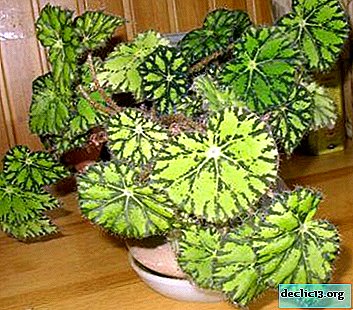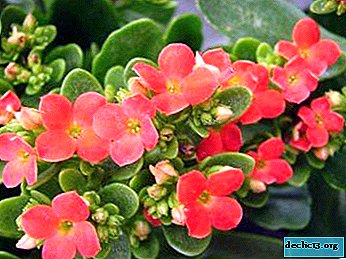Barbed Cactus - Lophophore Williams
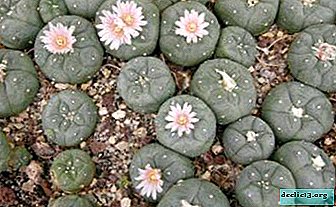
Lofofora Williams is of particular interest to lovers of cacti, as it has an unusual appearance and also has juice in its composition.
Juice can have a healing and tonic effect on the human body, but only if it is used in small doses. This article details how to care for a plant at home.
Lophophora williamsii: a botanical description
Lofofora Williams (Latin name: Lophophora williamsii), or, as it is also called, peyote, the plant was first described by the researcher of the Aztec history of Bernardino de Sahagun in the book A General History of the Affairs of New Spain in the 1570s. This species of cactus was used by natives in northern Mexico and the southwestern regions of the United States for traditional religious ceremonies (see cactus species here).
This representative of the cactus family has a spherical shape, slightly flattened, about 3-4 cm high, about 5-6 cm in diameter, with a velvety surface of light gray or bluish-gray color.
The root of the cactus is massive, the ribs are wide and slightly convex, separated by thin grooves. Spines are practically absent, in the upper part of the stem bunches of white or gray wool will be restrained (are there cacti without spines?). The flowers are white, pale pink, yellow, up to 2 cm in diameter (we talked about different cacti with pink flowers in a separate article). The fruits have an oblong shape and contain several seeds, appear about a year after flowering.
Peyote in natural habitats occupies a wide range - from the state of Texas in the United States to the state of Queretaro in Mexico. Also, these cacti are found on the slopes of the calcareous mountains in the states of Tamaulipas and San Luis Potosi.
Home Care
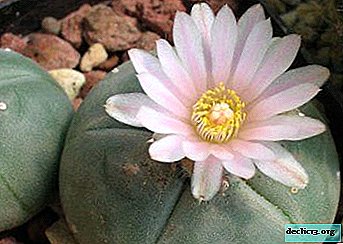 Temperature.
Temperature. For peyote, a moderate temperature is well suited, but an indicator of 30-40 degrees Celsius will not kill the plant. In autumn, it is recommended to lower the temperature to 5-10 degrees, but at the same time, maintain high illumination.
Humidity for this type of cactus does not matter.- Watering.
In summer, when watering the peyote, it is necessary to take into account the state of the soil in the pot: as soon as the soil is completely dry, you need to wait 1-2 days and moisten it. From late September to early March, watering a cactus is not recommended.
- Lighting.
Since the cactus in the wild grows under the shade of shrubs, it is not worth leaving it in direct sunlight: it will turn red and may die over time. Best looking windows facing west or east.
- Priming.
For transplanting Lofofra Williams, you can purchase both prepared soil intended for cacti and prepare the mixture yourself. It is important that the acidity does not exceed 6.6 pH.
In order to prepare the soil yourself, you need to mix:
- perlite - 2 parts;
- turf land - 1 part;
- brick chips - 1 part;
- bone meal - 10 g per 10 l of the mixture.
The main criterion for choosing a soil is high water permeability. Expanded clay, brick chips, clay shards can be used as drainage.
Important! When planting an adult plant, do not use the soil mixture, which includes vermiculite, since its structure is rapidly destroyed. - Top dressing.
Feeding is best done during the growing season. To do this, use special fertilizer for cacti, which is applied at intervals of 1 time in 4 weeks. During the wintering season, feeding is recommended to be stopped.
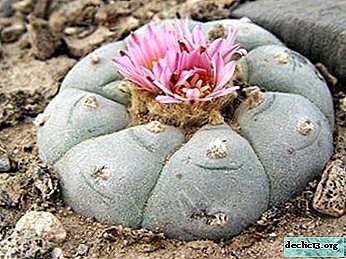 Pruning.
Pruning. If, during a cactus transplant, it was found that the roots had grown too much, then it is recommended to prune them. To do this, you must:
- Remove the plant from the pot and gently peel off the lumps of earth.
- Take a sharp blade, disinfect it with a solution of potassium permanganate.
- Trim the extra roots so that a third of the root system remains.
- Sprinkle the places of cuts with powdered coal and leave to dry.
- As soon as the slices are dry, plant in a new pot.
- Pot.
Since at Lofofora Williams, the root has a repetitive shape, the capacity for transplantation must be deep. Its diameter should exceed the size of the previous pot by at least 3 cm. A plastic or ceramic pot is best for this plant.
Important! If the pot was previously used for another plant, then it must be disinfected by washing with a potassium permanganate solution. - Transfer.
Adult specimens are recommended to be transplanted at the beginning of the growing season (most often in spring), with a frequency of once every 3 years. Young plants (up to three years) are recommended to be replanted every year.
In order to transplant a cactus, you must:
- Extract the plant from the pot, gently peel the clods of earth. Trim if necessary. If the roots were damaged during the extraction, they must be sprinkled with crushed coal and wait until the damaged areas dry out a little.
- At the bottom of the pot pour a layer of drainage. It can be expanded clay or crushed brick chips.
- Pour a little soil into the bottom of the pot, place a cactus in it so that the root looks straight down, sprinkle with earth, slightly compact.
- Cover the cactus with foil or place in a place with high humidity. 2 weeks after transplanting, the cactus must be watered.
- Wintering.
In the fall, with the onset of cold weather, peyote is no longer watered and cleaned in a cool place where the air temperature is about 5-10 degrees. If you continue to water the cactus during the cold wintering, then soon rot may appear on it.
Reproduction by children and seeds
 To get a new plant, you must either use lateral shoots (children) or sow seed material. Propagation by seed is the easiest way. Seeds can be bought in a store, ordered on the Internet, or obtained independently after the cactus has faded and the fruits ripen on it. Cacti can be sown at any time of the year.
To get a new plant, you must either use lateral shoots (children) or sow seed material. Propagation by seed is the easiest way. Seeds can be bought in a store, ordered on the Internet, or obtained independently after the cactus has faded and the fruits ripen on it. Cacti can be sown at any time of the year.
To do this, you must:
- Prepare a wide and shallow container.
- Pour soil into a container, consisting of three parts of flower soil and one part of coarse river sand.
- The surface of the soil must be moistened, pour the seeds on top and press them lightly.
- Cover the container with plastic wrap and put it in a warm place where the air temperature will be from 20 to 30 degrees.
- Germinate seeds must be in a place where the lighting will be at least 10 hours a day.
- After 1-1.5 months, the cacti will grow and get stronger, and they can be transplanted.
In order to propagate peyote by children, it is necessary:
- In autumn, carefully separate the processes from the mother's body.
- Take a wide container, fill it with perlite. Put the kids on perlite.
- Care for them as adult cacti in the winter. Do not water.
- In the spring, after they have roots, transplant into permanent pots.
Bloom
Lofophor Williams (in another translation of Williams) blooms throughout the summer, from June to September inclusive. Usually several times during the summer. Flowers appear on the top of the stem, most often have a pale pink color. During flowering, peyote is recommended to create maximum peace: do not move the flower pot to another place, limit watering, and do not create stressful conditions.
If the cactus does not bloom, then this means that:
- Wintering rules were violated (too high air temperature or watering).
- It was excessively plentiful in spring and summer.
Diseases and Pests
This type of plant is quite resistant to pests and diseases, and all problems arise due to violation of the rules for care.
Similar flowers
- Lofofora diffuse - has a spherical flattened shape, with a diameter of about 15 cm, a dull surface, yellowish-white flowers with a diameter of up to 2 cm.
- Lofofora Lutea - has a stalk of yellowish-green, brown or gray shade, with a diameter of not more than 10 cm. The flowers are yellowish-white or light yellow, with a diameter of not more than 3 cm.
- Verdant lophophora - has a dark green spherical stem, with a diameter of not more than 20 cm, with numerous ribs along the entire length. The flowers are white, diameter no more than 2 cm.
- Lofofora hedgehog - has a bluish-green stem, with a diameter of not more than 13 cm, with ribs and tubercles. There are tufts of wool on the surface. White flowers, diameter no more than 2 cm.
- Lofofra Mescaline - a small cactus, with a diameter of not more than 8 cm, gray-green color (learn about small cacti in this material). The top is rounded, on the surface there are crests with white hairs.
Everything that you need to know for the successful cultivation of Lofofora, we have collected in this article.
Thus, Lofofora Williams is one of the most unpretentious cacti, and at the same time has an unusual appearance and blooms, subject to simple care rules, all summer, delighting its owner with beautiful flowers.

 Temperature.
Temperature.  Pruning.
Pruning. 





